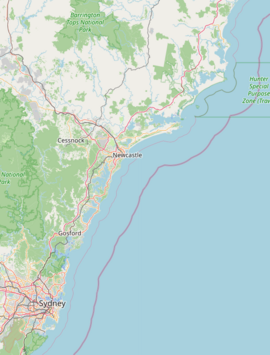Fennell Bay, New South Wales facts for kids
Quick facts for kids Fennell BayGreater Newcastle, New South Wales |
|||||||||||||||
|---|---|---|---|---|---|---|---|---|---|---|---|---|---|---|---|
| Population | 1,780 (2021 census) | ||||||||||||||
| • Density | 468/km2 (1,210/sq mi) | ||||||||||||||
| Established | 1882 | ||||||||||||||
| Postcode(s) | 2283 | ||||||||||||||
| Area | 3.8 km2 (1.5 sq mi) | ||||||||||||||
| Location | 3 km (2 mi) N of Toronto | ||||||||||||||
| LGA(s) | City of Lake Macquarie | ||||||||||||||
| Parish | Awaba | ||||||||||||||
| State electorate(s) | Lake Macquarie | ||||||||||||||
| Federal Division(s) | Hunter | ||||||||||||||
|
|||||||||||||||
Fennell Bay is a lovely suburb located by Lake Macquarie in New South Wales, Australia. It's part of the City of Lake Macquarie area, just north of the town of Toronto. This area is known for its beautiful bay, which shares the same name.
Contents
Fennell Bay's Ancient Past
First People and Ancient Forests
The Awabakal Aboriginal people were the first inhabitants of this land. Fennell Bay is very special because it holds Australia's first protected fossil forest. This ancient forest is important for both geological studies and Aboriginal history.
The trees in this fossil forest are from the Permian age, which is about 250 to 300 million years ago! These are the same kinds of trees that formed the nearby coal seams. The trees you see today are made of stone, or "silicified," and are still standing upright. Scientists believe they were buried by volcanic ash from a volcano that erupted long ago.
The Fossil Forest Story
The Fennell Bay fossil forest was first written about in 1834. A famous missionary, Reverend L.E. Threlkeld, recorded it in his book about the Aboriginal language. He wrote about a place called "Kurra-kurran" where there was a forest of stone trees.
Reverend Threlkeld also shared an amazing Aboriginal story about this place. The story says that long ago, a huge rock fell from the sky. It landed where many Aboriginal people were gathered. They had met there because a giant iguana from the sky told them to. The iguana was upset because they had been killing lice by roasting them.
The story also mentions that in those ancient times, the moon was a man named Pontobug. That's why the moon is still called "he" today. The sun, however, was a woman, so it's called "she." After the rock fell, the iguana went back up to the sky, where it is believed to be now.
In 1842, another important person visited the fossil forest: Reverend W.B. Clarke. He is sometimes called "The Father of Australian Geology." He was very impressed by the forest and wrote a paper about it. This paper was sent to London, which was a major center for geology at the time. It was one of the first serious geological studies to come out of Australia.
Reverend Clarke was deeply affected by the Fennell Bay forest. He wrote about how it showed the quiet processes of nature, like growth and decay, and how things change over time. He found it a "singular picture of the past and the present."
European History
The Fennell Bay area was divided into smaller plots of land in 1882. In the early days, there was a sawmill and a mine in the area. The first school in Fennell Bay opened in 1959. Today, this school has a special center that teaches about Aboriginal culture and history.


